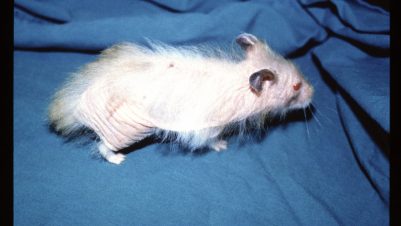Before assessing cutaneous adverse reactions to food (CAFR), ectoparasites and infections need to be identified and treated, and for this a thorough history, physical and dermatological examination with appropriate patient-side tests is essential.
Signs of adverse food reaction are non-specific and variable. In dogs there is a non-seasonal pruritus affecting many parts of the body and clinically indistinguishable from atopic dermatitis. Otitis externa is seen in many dogs and may be the only sign in some. As with atopic dermatitis, secondary infection with Staphylococcus pseudintermedius or Malassezia pachydermatis is common. In other dogs, recurrent superficial pyoderma is a feature. In cats, CAFR may result in any cutaneous reaction pattern, such as miliary dermatitis, symmetrical alopecia, eosinophilic granuloma complex or head and neck pruritus.
All dogs and cats suspected of an allergic skin condition should be subject to an investigation for CAFR. In theory, this should be straightforward. A “hypoallergenic” diet containing a novel protein that the animal has not been exposed to, and so not likely to be causing food intolerance, is fed for a period until resolution of the pruritus, and then challenged with the original diet. If relapse occurs within a short time, and improvement is noted on resuming the hypoallergenic diet, diagnosis of adverse food reaction is made. If there is no improvement on the diet, the diagnosis by default in allergic skin cases is atopic dermatitis.
Diagnosis of CAFR is challenging but stringent efforts to diagnose it are very worthwhile. A literature review (Olivry and Mueller, 2017) has estimated that the prevalence of cutaneous AFR in dogs and cats with skin disease is about 5 percent. The authors conclude that among dogs and cats with pruritus and those suspected of allergic skin disease, the prevalence of CAFR is high enough to justify that this syndrome is ruled out with an elimination-provocation dietary trial. This must especially be considered in animals with non-seasonal pruritus or signs of allergic dermatitis.
Currently the most reliable diagnostic test for CAFR is an elimination “hypoallergenic” diet. This might be a home-cooked diet, a commercial select protein diet or a hydrolysed diet. There is no consensus as to how long the diet should be fed. One study has indicated that the diet should be fed for as long as 12 weeks (Rosser, 1993).
Recently, an extensive literature search sought clarity on the duration of the elimination diet (Olivry et al., 2015). Based on the information gathered from 209 dogs with CAFR, it was estimated that after three weeks of a diet change, approximately half the dogs had achieved a marked reduction of their signs. From five weeks onwards, signs had returned to normal in 85 percent of dogs and this percentage increased to more than 95 percent if the dietary trial was extended to eight weeks. Fewer than 5 percent of dogs needed an elimination diet of up to 13 weeks.
To diagnose CAFR in at least 80 percent of dogs and cats, an elimination diet trial should last a minimum of five weeks in dogs and six weeks in cats. Increasing the duration of the trial to eight weeks will increase the sensitivity of diagnosis to more than 90 percent of cases.
Home-cooked diets
Most authorities have stated that a home-cooked diet is the most appropriate. Only one protein source, to which the dog or cat has no known previous exposure, is selected (eg venison), and fed with rice or potato. No other substances such as colourings or preservatives are present. Due to the length of time required, the home-cooked diet is challenging, requiring a dedicated owner and very good communication with the entire family and may therefore be more likely to result in failure due to lack of compliance. Furthermore, home-cooked diets are not balanced, and cannot be fed for any length of time, with supplementation being necessary.
If an animal responds to the diet, challenge with individual proteins one at a time for two weeks is undertaken until a relapse is seen. If the causative food is identified, it can be avoided with selective feeding. Many dogs and cats that respond to a hypoallergenic diet can be maintained on commercially available diets with limited novel proteins; this is a suitable option in these cases (Miller et al., 2013).
Commercial hypoallergenic diets
Commercial hypoallergenic diets have the attraction of being convenient, and therefore increase the possibility of good compliance. They are also balanced so they may be used for long-term management. Although these diets offer convenience, they are not 100 percent effective. Commercial hypoallergenic diets consist of either a select protein with one carbohydrate source (for dogs) or are hydrolysed.
Select protein diets
There are many commercial diets with alleged hypoallergenic properties. Select those that are accurately labelled (if possible) to ensure the diet does not contain a food known to have been previously eaten. Advice from a veterinary dermatologist will be useful in selecting appropriate diets. A recent study (Olivry and Mueller, 2018) found that it was common for there to be unexpected protein sources, detected by PCR, ELISA or mass spectrometry, in some “hypoallergenic” diets, which may explain why some diets fail. The authors state that there is insufficient information to determine if the presence of contaminating components will lead to an allergic reaction to such ingredients. Of interest, in this study, the testing of hydrolysate-containing pet foods found only one instance of possible mislabelling.
Another study suggests that prescription vegetarian diets may be effective in diagnosing and managing CAFR if any potential contaminant proteins can be shown to be absent (Aufox et al., 2018). A pilot study was undertaken with three dogs that had a history of pruritus and recurrent pyoderma. The dogs were fed a vegetarian prescription diet that had been subjected to PCR analysis for DNA of 11 mammalian species and for poultry DNA, with negative findings. Two of the dogs were diagnosed with CAFR and the third, which had already been diagnosed, was successfully managed long-term with the diet.
Hydrolysed diets
Hydrolysed diets were introduced in recent years with the aim to improve the diagnosis and management of CAFR. It is suggested that these diets are hypoallergenic because the protein component is broken down into small units that do not induce hypersensitivity. Initial studies have shown comparable success rates in diagnosing CAFR to home-cooked diets (Miller et al., 2013). Residual antigenicity to a protein source cannot be ruled out completely, however, and some dogs may not have type 1 hypersensitivity.
Compliance problems are best addressed with a teamwork approach involving veterinary surgeons and suitably trained veterinary nurses, emphasising the importance, particularly during the diagnostic phase, of ensuring that the animal only eats the prescribed diet. This may involve an attempt to keep cats indoors for the first six weeks at least, and strict supervision of dogs when they are outside. Cats are more likely than dogs to refuse the diet. If this problem occurs, it may be solved through trying several hypoallergenic diets; one may prove to be more palatable.
In summary
Dogs and cats with allergic skin disease will be pruritic in the majority of cases. Parasitic and infectious causes are eliminated before an allergy investigation; a hypoallergenic elimination diet is the next step and essential in all cases, as the incidence of CAFR is sufficiently high to warrant investigation. Elimination diets offer the best option for diagnosis and long-term control of CAFR. Commercial hypoallergenic diets are increasing in number and should be checked for ingredients. Advice from a veterinary dermatologist on suitable diets is advisable. Teamwork is essential to help the owner overcome hurdles during the diagnostic phase; in the majority of cases, this is six to eight weeks.
A full reference list is available on request.







-1628179421-401x226.jpg)



